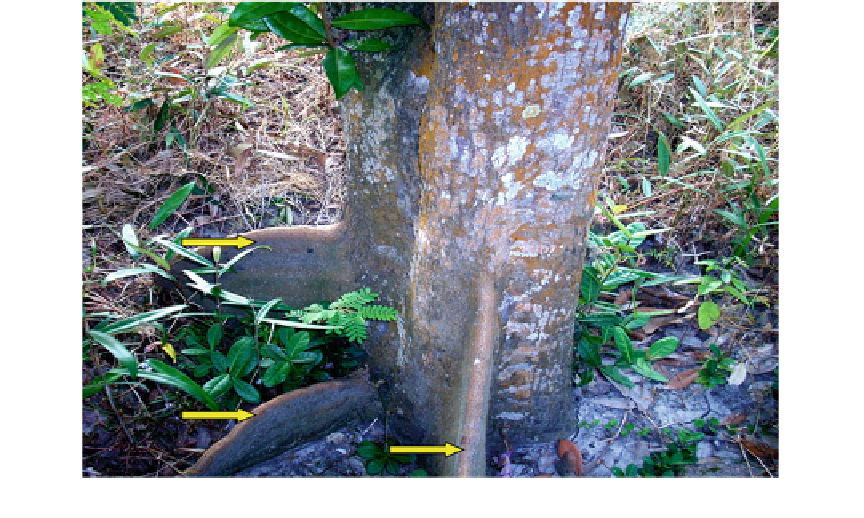Environmental Engineering Reference
In-Depth Information
Fig. 4.12
Buttress root of
H. fomes
(marked with
yellow arrows
): a unique feature of the species
productivity when exposed to increased carbon
dioxide. Snedaker and Ara
maturation in addition to growth. However,
Ellison and Farnsworth (
1996
) predict that whe-
ther increased atmospheric carbon dioxide results
in enhanced growth of mangroves, it will likely
not be enough to compensate for the negative
impacts of sea-level rise.
It has been reported that mangroves are among
the most carbon-dense forests in the tropics
(sample-wide mean: 1,023 MgC ha
−
1
jo (
1998
) suggest
that increased levels of carbon dioxide on a
global scale may result in a competitive disad-
vantage of
ú
in mixed mangrove
communities relative to the other species whose
rates of net primary productivity are not signi
L. racemosa
-
cantly affected by increases in carbon dioxide.
The results of this study indicate that global
increases in carbon dioxide may result in a
competitive advantage of mangroves in arid
regions due to their ability to minimize water use
during periods of water stress while maintaining
relatively high rates of carbon dioxide uptake
(Snedaker and Ara
88 s:e:m:)
and exceptionally high compared to mean carbon
storage of the world
±
s major forest domains (Do-
nato et al.
2011
). Estuarine sites contained a mean
of 1,074 MgC ha
−
1
'
171 s:e:m:); oceanic sites
contained 990
±
96 MgC ha
−
1
. AGC pools were
sizeable (mean 159 MgC ha
−
1
, maximum
435 MgC ha
−
1
), but belowground storage in soils
dominated, accounting for 71
(
±
jo
1998
).
Farnsworth et al. (
1996
) analysed the effects
of doubled levels of carbon dioxide on
ú
R. mangle
seedlings. The seedlings demonstrated signi
90 %
of total storage in estuarine and oceanic sites,
respectively. High per-hectare carbon storage
coupled with a pantropical distribution (total area
*
98 % and 49
-
-
cant
increases in biomass, total stem length, branch-
ing activity and total leaf area compared to
seedlings grown in normal levels of carbon
dioxide. In this study, reproduction of
14 million hectares; FAO
2007
; Bouillon et al.
2009
), suggests mangroves are a globally impor-
tant surface carbon reserve.
A pilot project undertaken in the Indian Sun-
darbans region with the
R. mangle
was achieved after only one year of growth in a
high carbon dioxide environment, whereas it
typically takes a full two years before they are
able to reproduce in the
nancial assistance of
Ministry of Earth Science, Government of India
revealed signi
eld; thus, elevated
carbon dioxide also appeared to accelerate
cant spatial differences of stored

